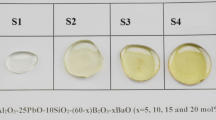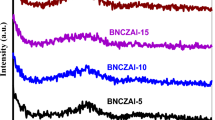Abstract
In the present work, a novel glass system, 10Na2O–6MgO–9CaO–5Al2O3–12B2O3-(100−x)SiO2–xBi2O3 (x: 0, 2.5, 5, 7.5, and 10 mol%), was investigated in terms of physical properties and radiation shielding competencies. For this, the ABS glass series was successfully synthesized by following batch preparation, melting, shaping, and annealing steps. Mineralogical analysis X-ray diffraction (XRD) and glass density (ρglass) were measured, while molar volume (Vm) and oxygen packing density (OPD) calculations were done for each glass series. We determined that the increasing amount in Bi2O3 in substitution for SiO2 ascended the overall ρglass from 2.8067 to 3.3067 g/cm3. Further, one can report that Vm and OPD exhibited an opposite behavior due to the loose packing in the glass network. The XRD patterns clearly indicated the non-crystallinity in the ABS series irrespective of the varying amounts in Bi2O3. On the other hand, gamma-ray spectroscopic measurements were performed in the photon energies of 0.662, 1.173, and 1.332 MeV to find out mass attenuation coefficient (MAC). It was observed that the highest MAC value was obtained for ABS4 glass (highest Bi2O3 content). Additionally, Monte Carlo simulation codes (MCNP-X) were employed to highlight the MAC values. As a result of these determinations, we reported that the experimental, XCOM, and MCNP-X findings demonstrated a good agreement with each other. Based on the experimental MAC, other significant parameters, such as the half-value layer (HVL), tenth-value layer (TVL), effective atomic numbers (Zeff), and Exposure Build-up Factors (EBF) and Energy Absorption Build-up Factors (EABF) were evaluated for the investigated ABS glass system.






















Similar content being viewed by others
References
B. Karasu, O. Bereket, E. Biryan, D. Sanoğlu, The latest developments in glass science and technology. El-Cezeri Fen veMühendislikDerg. 4(2), 209–233 (2017). https://doi.org/10.31202/ecjse.318204
E.D. Zanotto, J.C. Mauro, The glassy state of matter: its definition and ultimate fate. J. Non-Cryst. Solids 471, 490–495 (2017). https://doi.org/10.1016/j.jnoncrysol.2017.05.019
H.A. Saudi, W.M. Abd-Allah, K.S. Shaaban, Investigation of gamma and neutron shielding parameters for borosilicate glasses doped europium oxide for the immobilization of radioactive waste. J. Mater. Sci. Mater. Electron. 31(9), 6963–6976 (2020). https://doi.org/10.1007/s10854-020-03261-6
M.I. Sayyed, Y. Elmahroug, B.O. Elbashir, S.A.M. Issa, Gamma-ray shielding properties of zinc oxide soda lime silica glasses. J. Mater. Sci. Mater. Electron. 28(5), 4064–4074 (2017). https://doi.org/10.1007/s10854-016-6022-z
A.S. Abouhaswa, H.M.H. Zakaly, S.A.M. Issa, M. Pyshkina, R. El-Mallawany, M.Y.A. Mostafa, Lead borate glasses and synergistic impact of lanthanum oxide additive: optical and nuclear radiation shielding behaviors. J. Mater. Sci. Mater. Electron. 31(17), 14494–14501 (2020). https://doi.org/10.1007/s10854-020-04009-y
M. Kurudirek, N. Chutithanapanon, R. Laopaiboon, C. Yenchai, C. Bootjomchai, Effect of Bi2O3 on gamma ray shielding and structural properties of borosilicate glasses recycled from high pressure sodium lamp glass. J. Alloys Compd. 745, 355–364 (2018). https://doi.org/10.1016/j.jallcom.2018.02.158
H. Donya, S. Sulami, Photon shielding characterization of a modified titania-bismuth-borotellurite glass system for medical applications. J. Korean Phys. Soc. 75(11), 871–877 (2019). https://doi.org/10.3938/jkps.75.871
E.S.A. Waly, G.S. Al-Qous, M.A. Bourham, Shielding properties of glasses with different heavy elements additives for radiation shielding in the energy range 15–300 keV. Radiat. Phys. Chem. 150(February), 120–124 (2018). https://doi.org/10.1016/j.radphyschem.2018.04.029
M.K. Halimah, A. Azuraida, M. Ishak, L. Hasnimulyati, Influence of bismuth oxide on gamma radiation shielding properties of boro-tellurite glass. J. Non. Cryst. Solids 512(2018), 140–147 (2019). https://doi.org/10.1016/j.jnoncrysol.2019.03.004
Y.S. Rammah et al., SnO reinforced silicate glasses and utilization in gamma radiation shielding applications. Emerg. Mater. Res. 9(3), 1–8 (2020). https://doi.org/10.1680/jemmr.20.00150
R.B. Malidarre, F. Kulali, A. Inal, A. Oz, Monte Carlo simulation of the waste soda-lime-silica glass system contained Sb2O3 for Gamma-ray shielding. Emerg. Mater. Res. 9(4), 1–7 (2020). https://doi.org/10.1680/jemmr.20.00202
M. Eshghi, Investigation of radiation protection features of the TeO2–B2O3–Bi2O3–Na2O–NdCl3 glass systems. J. Mater. Sci. Mater. Electron. (2020). https://doi.org/10.1007/s10854-020-04202-z
A.K. Varshneya, J.C. Mauro, Fundamentals of Inorganic Glass Making (Elsevier, Amsterdam, 2019).
S.A.M. Issa, M.I. Sayyed, A.M.A. Mostafa, G. Lakshminarayana, I.V. Kityk, Investigation of mechanical and radiation shielding features of heavy metal oxide based phosphate glasses for gamma radiation attenuation applications. J. Mater. Sci. Mater. Electron. 30(13), 12140–12151 (2019). https://doi.org/10.1007/s10854-019-01572-x
Y. Al-Hadeethi, S.A. Tijani, The use of lead-free transparent 50BaO-(50–x)borosilicate-xBi2O3 glass system as radiation shields in nuclear medicine. J. Alloys Compd. 803, 625–630 (2019). https://doi.org/10.1016/j.jallcom.2019.06.259
M. Hasanuzzaman, A. Rafferty, M. Sajjia, A.-G. Olabi, Properties of Glass Materials. Reference Module in Materials Science and Materials Engineering (Elsevier, Amsterdam, 2016).
L.S. Ravangave, G.N. Devde, Structure and physical properties of 59B2O3–10Na2O–(30–x)CdO–xZnO–1CuO (0 ≤ x ≤ 30) glass system. Adv. Glass Sci. Technol. (2018). https://doi.org/10.5772/intechopen.73865
Y.T. Shih, J.H. Jean, Composition-structure-properties relationship of lithium-calcium borosilicate glasses studied by molecular dynamics simulation. Ceram. Int. 44(10), 11554–11561 (2018). https://doi.org/10.1016/j.ceramint.2018.03.216
S. Konoshita, F. Sato, S. Yoshihara, A. Sakamoto, Influence of platinum, antimony and iron ions on coloration of alkali-borosilicate optical glass. Opt. Mater. (Amst) 34(4), 600–603 (2012). https://doi.org/10.1016/j.optmat.2011.08.035
R.K. Mishra et al., A comparative study on the structural aspects of sodium borosilicate glasses and barium borosilicate glasses: effect of Al2O3 addition. J. Non. Cryst. Solids 447, 283–289 (2016). https://doi.org/10.1016/j.jnoncrysol.2016.04.040
V.E. Eremyashev, D.A. Zherebtsov, L.M. Osipova, M.V. Brazhnikov, Effect of calcium, barium, and strontium on the thermal properties of borosilicate glasses. Glass Ceram. (English Transl. StekloiKeramika) 74(9–10), 345–348 (2018). https://doi.org/10.1007/s10717-018-9991-y
H.O. Tekin et al., Nuclear radiation shielding competences of barium (Ba) reinforced borosilicate glasses. Emerg. Mater. Res. 9(4), 1–12 (2020). https://doi.org/10.1680/jemmr.20.00185
Y. Al-Hadeethi, M.I. Sayyed, Analysis of borosilicate glasses doped with heavy metal oxides for gamma radiation shielding application using Geant4 simulation code. Ceram. Int. 45(18), 24858–24864 (2019). https://doi.org/10.1016/j.ceramint.2019.08.234
I. Boukhris, I. Kebaili, M.S. Al-Buriahi, B. Tonguc, M.M. AlShammari, M.I. Sayyed, Effect of bismuth oxide on the optical features and gamma shielding efficiency of lithium zinc borate glasses. Ceram. Int. 46(14), 22883–22888 (2020). https://doi.org/10.1016/j.ceramint.2020.06.061
H.O. Tekin et al., Synthesis and nuclear radiation shielding characterization of newly developed germanium oxide and bismuth oxide glasses. Ceram. Int. 45(18), 24664–24674 (2019). https://doi.org/10.1016/j.ceramint.2019.08.204
R. Bagheri, A. KhorramiMoghaddam, H. Yousefnia, Gamma ray shielding study of barium–bismuth–borosilicate glasses as transparent shielding materials using MCNP-4C Code, XCOM program, and available experimental data. Nucl. Eng. Technol. 49(1), 216–223 (2017). https://doi.org/10.1016/j.net.2016.08.013
R. Kurtulus, T. Kavas, I. Akkurt, K. Gunoglu, An experimental study and WinXCom calculations on X-ray photon characteristics of Bi2O3- and Sb2O3-added waste soda-lime-silica glass. Ceram. Int. 46(September), 21120–21127 (2020). https://doi.org/10.1016/j.ceramint.2020.05.188
A.H. Ghanem, A.T.M. Farag, A.G. Al-Sehemi, A. Al-Ghamdi, W.A. Farooq, F. Yakuphanoglu, Bismuth borate glass based nuclear materials. SILICON 10(3), 1195–1201 (2018). https://doi.org/10.1007/s12633-017-9593-2
O. Sanz, E. Haro-Poniatowski, J. Gonzalo, J.M. Fernández Navarro, Influence of the melting conditions of heavy metal oxide glasses containing bismuth oxide on their optical absorption. J. Non. Cryst. Solids 352(8), 761–768 (2006). https://doi.org/10.1016/j.jnoncrysol.2006.02.002
M.S. Al-Buriahi et al., Influence of Bi2O3/PbO on nuclear shielding characteristics of lead-zinc-tellurite glasses. Phys. B Condens. Matter 581(December), 411946 (2020). https://doi.org/10.1016/j.physb.2019.411946
Y.S. Rammah, K.A. Mahmoud, E. Kavaz, A. Kumar, F.I. El-Agawany, The role of PbO/Bi2O3 insertion on the shielding characteristics of novel borate glasses. Ceram. Int. (2020). https://doi.org/10.1016/j.ceramint.2020.04.018
İ Akkurt, S.S. Arda, K. Gunoglu, Variation of energy resolution with distance for a NaI(Tl) detector. Acta Phys. Polon. A (2015). https://doi.org/10.12693/APhysPolA.128.B-422
İ Akkurt, F. Waheed, H. Akyildirim, K. Gunoglu, Monte Carlo simulation of a NaI(Tl) detector efficiency. Radiat. Phys. Chem. 176, 109081 (2020). https://doi.org/10.1016/j.radphyschem.2020.109081
I. Akkurt, K. Gunoglu, S.S. Arda, Detection efficiency of NaI(Tl) detector in 511–1332 keV energy range. Sci. Technol. Nucl. Install. (2014). https://doi.org/10.1155/2014/186798
Y.Y. Çelen, A. Evcin, Synthesis and characterizations of magnetite-borogypsum for radiation shielding. Emerg. Mater. Res. 9(3), 1–7 (2020). https://doi.org/10.1680/jemmr.20.00098
A. Özseven, I. Akkurt, K. Günoğlu, Determination of some dosimetric parameters in Eğirdir Lake, Isparta, Turkey. Int. J. Environ. Sci. Technol. 17(3), 1503–1510 (2020). https://doi.org/10.1007/s13762-019-02569-z
I. Akkurt, Effective atomic and electron numbers of some steels at different energies. Ann. Nucl. Energy 36(11–12), 1702–1705 (2009). https://doi.org/10.1016/j.anucene.2009.09.005
I. Akkurt, H. Akyýldýrým, B. Mavi, S. Kilincarslan, C. Basyigit, Photon attenuation coefficients of concrete includes barite in different rate. Ann. Nucl. Energy 37(7), 910–914 (2010). https://doi.org/10.1016/j.anucene.2010.04.001
I. Akkurt, C. Basyigit, S. Kilincarslan, B. Mavi, A. Akkurt, Radiation shielding of concretes containing different aggregates. Cem. Concr. Compos. 28(2), 153–157 (2006). https://doi.org/10.1016/j.cemconcomp.2005.09.006
R. C. C. Collection, MCNPX user’s manual version 2.4.0. Monte Carlo N-particle transport code system for multiple and high energy applications (2002)
“NIST XCOM: Element/compound/mixture (2020). https://physics.nist.gov/PhysRefData/Xcom/html/xcom1.html. Accessed 14 Feb 2020
I. Akkurt, H.O. Tekin, Radiological parameters for bismuth oxide glasses using phy-x/psd software. Emerg. Mater. Res. 9(3), 1–9 (2020). https://doi.org/10.1680/jemmr.20.00209
H.O. Tekin et al., Structural and physical characterization study on synthesized tellurite (TeO2) and germanate (GeO2) glass shields using XRD, Raman spectroscopy, FLUKA and PHITS. Opt. Mater. (Amst.) 110, 110533 (2020). https://doi.org/10.1016/j.optmat.2020.110533
A.M.A. Mostafa et al., Multi-objective optimization strategies for radiation shielding performance of BZBB glasses using Bi2O3: a FLUKA Monte Carlo code calculations. J. Mater. Res. Technol. 9(6), 12335–12345 (2020). https://doi.org/10.1016/j.jmrt.2020.08.077
G. Kilic, S.A.M. Issa, E. Ilik, O. Kilicoglu, H.O. Tekin, A journey for exploration of Eu2O3 reinforcement effect on zinc-borate glasses: Synthesis, optical, physical and nuclear radiation shielding properties. Ceram. Int. (2020). https://doi.org/10.1016/j.ceramint.2020.09.103
S.A.M. Issa et al., Fabrication, optical characteristic, and nuclear radiation shielding properties of newly synthesisedPbO–GeO2 glasses. Appl. Phys. A Mater. Sci. Process. 126(9), 748 (2020). https://doi.org/10.1007/s00339-020-03928-1
K.S. Mann, S.S. Mann, Py-MLBUF: development of an online-platform for gamma-ray shielding calculations and investigations. Ann. Nucl. Energy 150, 107845 (2021). https://doi.org/10.1016/j.anucene.2020.107845
M.S. Al-Buriahi, K.S. Mann, Radiation shielding investigations for selected tellurite-based glasses belonging to the TNW system. Mater. Res. Express 6(10), 105206 (2019). https://doi.org/10.1088/2053-1591/ab3f85
F. Kulali, Simulation studies on radiological parameters for marble concrete. Emerg. Mater. Res. 9(4), 1–7 (2020). https://doi.org/10.1680/jemmr.20.00307
Author information
Authors and Affiliations
Corresponding author
Additional information
Publisher's Note
Springer Nature remains neutral with regard to jurisdictional claims in published maps and institutional affiliations.
Rights and permissions
About this article
Cite this article
Kurtulus, R., Kavas, T., Akkurt, I. et al. A comprehensive study on novel alumino-borosilicate glass reinforced with Bi2O3 for radiation shielding applications: synthesis, spectrometer, XCOM, and MCNP-X works. J Mater Sci: Mater Electron 32, 13882–13896 (2021). https://doi.org/10.1007/s10854-021-05964-w
Received:
Accepted:
Published:
Issue Date:
DOI: https://doi.org/10.1007/s10854-021-05964-w




